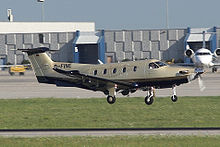Pilatus PC-12
The Pilatus PC-12 is a single-engine turboprop passenger and cargo aircraft manufactured by Pilatus Aircraft of Switzerland. The main market for the aircraft is corporate transport and regional airliner operators.
Design and development
Pilatus announced the development of the PC-12 at the National Business Aircraft Association's annual convention in October 1989. The first flight of the first of two prototypes took place on 31 May 1991. Certification of the type was originally planned for mid-1991 but a redesign of the wings (increase of wing span and addition of winglets to ensure performance guarantees were met) delayed this. Swiss certification finally took place on 30 March 1994 and FAA approval followed on 15 July 1994.
As with many other Pilatus aircraft, the PC-12 is powered by a single Pratt & Whitney Canada PT6A-67B turboprop engine. It is certified for single-pilot IFR operations, though operators may choose to utilize a second flight crew member. The PC-12 is offered in standard nine-seat airliner form, in a four-passenger seat/freight combi version and as a six-place corporate transport. A pure freighter model is under consideration.
The U-28A is the United States Air Force variant of the PC-12 for intra-theater support of special operations forces. The 319th Special Operations Squadron is stationed at Hurlburt Field, Florida at the headquarters of the Air Force Special Operations Command.
Pilatus unveiled the PC-12 47/E (Next Generation) at the 2007 National Business Aircraft Association meeting in Atlanta. The 47/E model features a more powerful Pratt & Whitney PT6-67P engine with better climb performance and an increase in maximum cruise speed to 280kts TAS. The Next Generation aircraft also features a Honeywell APEX Glass Cockpit. The revised cockpit includes automatic pressurization control as well as cursor controlled inputs to the navigation system. Along with the engine and avionics upgrade, BMW DesignWorks were recruited to update the interior. The Next Generation aircraft starts with serial number 1001 and the last generation (legacy aircraft) finishes at serial number 888.
Operational history


Most PC-12s are used as corporate transports, but recent regulatory changes in Australia, Brazil, Canada and the United States have cleared single engine turboprops such as the PC-12 for regional passenger transport operations in those nations. This has opened up a new potential market for the PC-12 as a regional airliner, in order to replace older twin piston-engined aircraft.
Planesense, a New Hampshire-based fractional ownership company, is the largest fractional operator of PC-12s in the world, operating 34 PC-12s.[1] Their aircraft have logged over 80,000 flight hours.
The Royal Flying Doctor Service of Australia were the launch customer for the PC-12 in 1994. The RFDS operate 20 PC-12 aircraft with more to follow and have logged more than 120,000 hours.[citation needed]
Variants
- Basic options
- Nine-seat standard passenger airliner.
- Six to eight seat executive corporate transport.
- Four-seat passenger/cargo combination.
- All-cargo transport.
- PC-12M
The PC-12M (the M stands for multipurpose) is based on the basic PC-12 but equipped with a more powerful electrical generation system in order to enable the integration of additional power-consuming equipment. This enables the PC-12M to perform special mission tasks such as flight inspection, air ambulance, parachutist dropping, aerial photography and aerial surveillance. This version is marketed in the United States as the PC-12 Spectre paramilitary special missions platform.
Operators

Civilian Users
More than 780 PC-12s have been sold as of June 2008; most are used in the civil market.
Military Users
- Bulgarian Air Force, since 2003.
- South African Air Force, 41 Squadron.
- United States Air Force - U-28A
Specifications (nine-passenger PC-12)

General characteristics
- Crew: one or two pilots
- Capacity: 9 passengers standard, 6-8 executive
- Maximum landing: 4,700 kg (10,450 lb)
- Maximum payload full fuel: 539 kg (1,189 lb)
- Tail wingspan: 5.20 m (17 ft 1 in)
- Propeller: Hartzell HC - E4A - 3D/E10477K – 4 blade aluminum
- Propeller diameter: 2.67 m (8 ft 9 in)
- Propeller RPM: 1,700 rpm constant speed
Performance
- Range 0 passenger: 4,149 km (2,593 mi) (2,239 nm)
- Range 9 passenger: 2,804 km (1,753 mi) (1,513 nm)
- Takeoff distance over 15 m (50 ft) obstacle: 701 m (2,300 ft)
- Takeoff distance ground roll: 450 m (1,475 ft)
- Landing distance over 15 m (50 ft) obsacle: 558 m (1,830 ft)
- Landing distance ground roll: 228 m (945 ft)
See also
Aircraft of comparable role, configuration, and era
References
Notes
Bibliography
- Endres, Günter. The Illustrated Directory of Modern Commercial Aircraft. St. Paul, Minnesota: MBI Publishing, 2001. ISBN 0-7603-1125-0.
- The information on the U-28A was obtained from an official United States Air Force fact sheet
External links
- Kelner Pilatus PC.12
- Pilatus PC 12
- Flight International article on the Pilatus PC 12 Next Generation
